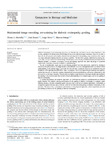Mostrar o rexistro simple do ítem
Multimodal Image Encoding Pre-training for Diabetic Retinopathy Grading
| dc.contributor.author | Hervella, Álvaro S. | |
| dc.contributor.author | Rouco, J. | |
| dc.contributor.author | Novo Buján, Jorge | |
| dc.contributor.author | Ortega Hortas, Marcos | |
| dc.date.accessioned | 2022-06-10T17:23:20Z | |
| dc.date.available | 2022-06-10T17:23:20Z | |
| dc.date.issued | 2022 | |
| dc.identifier.citation | HERVELLA, Álvaro S., et al. Multimodal image encoding pre-training for diabetic retinopathy grading. Computers in Biology and Medicine, 2022, vol. 143, p. 105302. https://doi.org/10.1016/j.compbiomed.2022.105302 | es_ES |
| dc.identifier.uri | http://hdl.handle.net/2183/30885 | |
| dc.description | Financiado para publicación en acceso aberto: Universidade da Coruña/CISUG | es_ES |
| dc.description.abstract | [Abstract] Diabetic retinopathy is an increasingly prevalent eye disorder that can lead to severe vision impairment. The severity grading of the disease using retinal images is key to provide an adequate treatment. However, in order to learn the diverse patterns and complex relations that are required for the grading, deep neural networks require very large annotated datasets that are not always available. This has been typically addressed by reusing networks that were pre-trained for natural image classification, hence relying on additional annotated data from a different domain. In contrast, we propose a novel pre-training approach that takes advantage of unlabeled multimodal visual data commonly available in ophthalmology. The use of multimodal visual data for pre-training purposes has been previously explored by training a network in the prediction of one image modality from another. However, that approach does not ensure a broad understanding of the retinal images, given that the network may exclusively focus on the similarities between modalities while ignoring the differences. Thus, we propose a novel self-supervised pre-training that explicitly teaches the networks to learn the common characteristics between modalities as well as the characteristics that are exclusive to the input modality. This provides a complete comprehension of the input domain and facilitates the training of downstream tasks that require a broad understanding of the retinal images, such as the grading of diabetic retinopathy. To validate and analyze the proposed approach, we performed an exhaustive experimentation on different public datasets. The transfer learning performance for the grading of diabetic retinopathy is evaluated under different settings while also comparing against previous state-of-the-art pre-training approaches. Additionally, a comparison against relevant state-of-the-art works for the detection and grading of diabetic retinopathy is also provided. The results show a satisfactory performance of the proposed approach, which outperforms previous pre-training alternatives in the grading of diabetic retinopathy. | es_ES |
| dc.description.sponsorship | This work is supported by Instituto de Salud Carlos III, Government of Spain, and the European Regional Development Fund (ERDF) of the European Union (EU) through the DTS18/00136 research project; Ministerio de Ciencia e Innovación, Government of Spain, through the RTI2018-095894-B-I00 and PID2019-108435RB-I00 research projects; Axencia Galega de Innovación (GAIN), Xunta de Galicia, ref. IN845D 2020/38; Consellería de Cultura, Educación e Universidade, Xunta de Galicia, through Grupos de Referencia Competitiva, grant ref. ED431C 2020/24. CITIC, Centro de Investigación de Galicia ref. ED431G 2019/01, receives financial support from Consellería de Educación, Universidade e Formación Profesional, Xunta de Galicia, through the ERDF (80%) and Secretaría Xeral de Universidades (20%). Funding for open access charge: Universidade da Coruña/CISUG | es_ES |
| dc.description.sponsorship | Xunta de Galicia; IN845D 2020/38 | es_ES |
| dc.description.sponsorship | Xunta de Galicia; ED431C 2020/24 | es_ES |
| dc.description.sponsorship | Xunta de Galicia; ED431G 2019/01 | es_ES |
| dc.language.iso | eng | es_ES |
| dc.publisher | Elsevier | es_ES |
| dc.relation | info:eu-repo/grantAgreement/ISCIII/Plan Estatal de Investigación Científica y Técnica y de Innovación 2013-2016/DTS18%2F00136/ES/PLATAFORMA ONLINE PARA PREVENCION Y DETECCION PRECOZ DE ENFERMEDAD VASCULAR MEDIANTE ANALISIS AUTOMATIZADO DE INFORMACION E IMAGEN CLINICA/ | |
| dc.relation | info:eu-repo/grantAgreement/AEI/Plan Estatal de Investigación Científica y Técnica y de Innovación 2017-2020/RTI2018-095894-B-I00/ES/DESARROLLO DE TECNOLOGIAS INTELIGENTES PARA DIAGNOSTICO DE LA DMAE BASADAS EN EL ANALISIS AUTOMATICO DE NUEVAS MODALIDADES HETEROGENEAS DE ADQUISICION DE IMAGEN OFTALMOLOGICA/ | |
| dc.relation | info:eu-repo/grantAgreement/AEI/Plan Estatal de Investigación Científica y Técnica y de Innovación 2017-2020/PID2019-108435RB-I00/ES/CUANTIFICACION Y CARACTERIZACION COMPUTACIONAL DE IMAGEN MULTIMODAL OFTALMOLOGICA: ESTUDIOS EN ESCLEROSIS MULTIPLE/ | |
| dc.relation.uri | https://doi.org/10.1016/j.compbiomed.2022.105302 | es_ES |
| dc.rights | Atribución-NoComercial-SinDerivadas 4.0 Internacional | es_ES |
| dc.rights.uri | http://creativecommons.org/licenses/by-nc-nd/4.0/ | * |
| dc.subject | Diabetic retinopathy | es_ES |
| dc.subject | Computer-aided diagnosis | es_ES |
| dc.subject | Medical imaging | es_ES |
| dc.subject | Self-supervised learning | es_ES |
| dc.subject | Deep learning | es_ES |
| dc.subject | Eye fundus | es_ES |
| dc.title | Multimodal Image Encoding Pre-training for Diabetic Retinopathy Grading | es_ES |
| dc.type | info:eu-repo/semantics/article | es_ES |
| dc.rights.access | info:eu-repo/semantics/openAccess | es_ES |
| UDC.journalTitle | Computers in Biology and Medicine | es_ES |
| UDC.volume | 143 | es_ES |
| UDC.startPage | 105302 | es_ES |
| dc.identifier.doi | 10.1016/j.compbiomed.2022.105302 |
Ficheiros no ítem
Este ítem aparece na(s) seguinte(s) colección(s)
-
GI-VARPA - Artigos [76]






